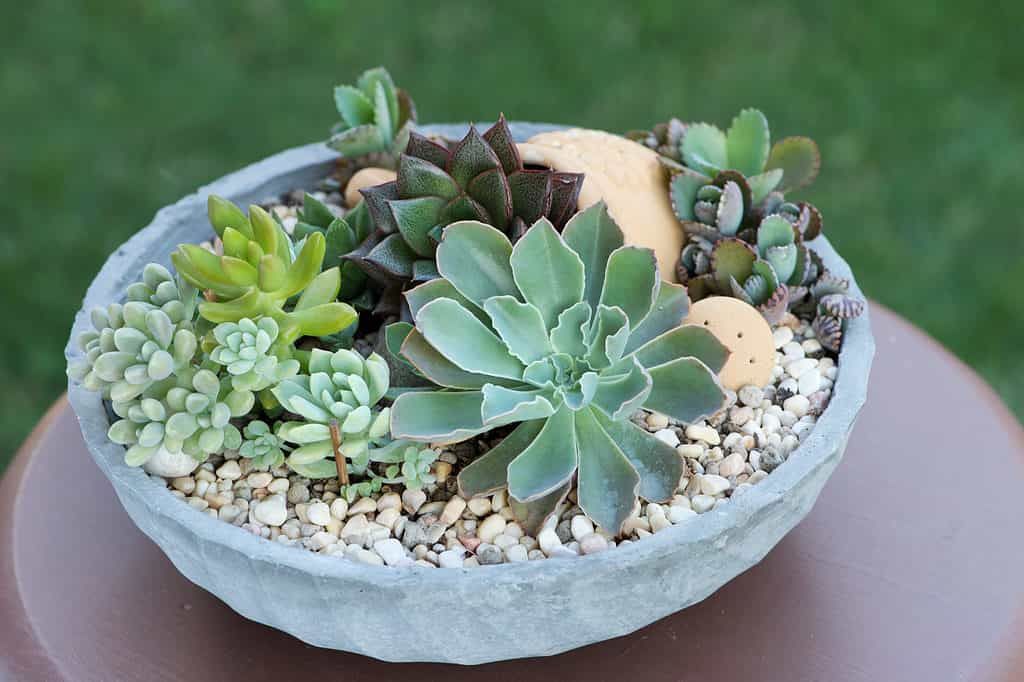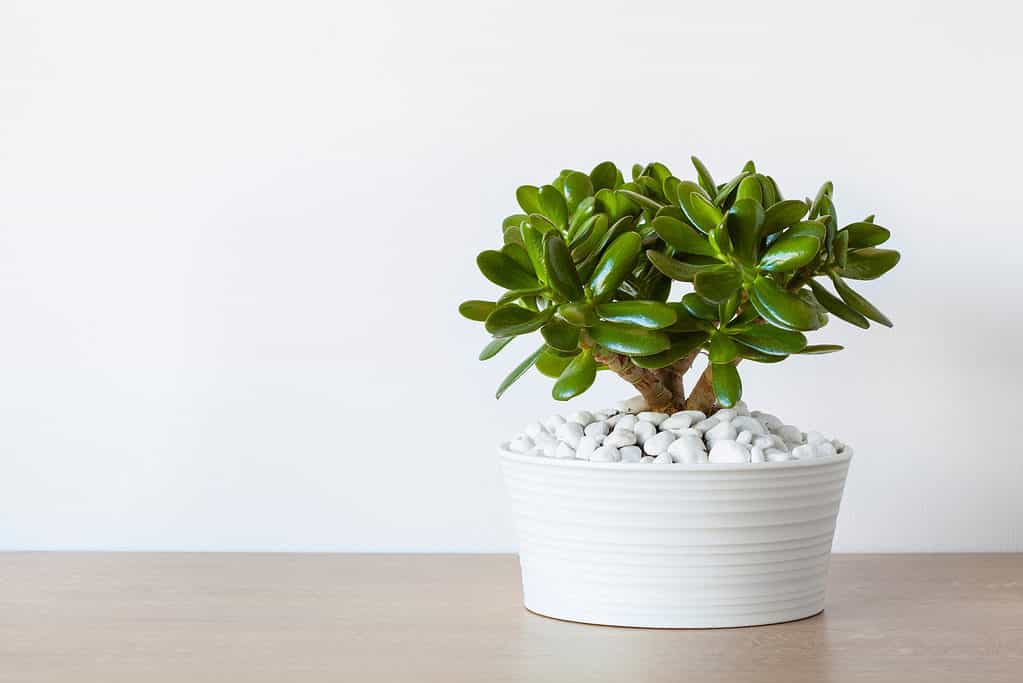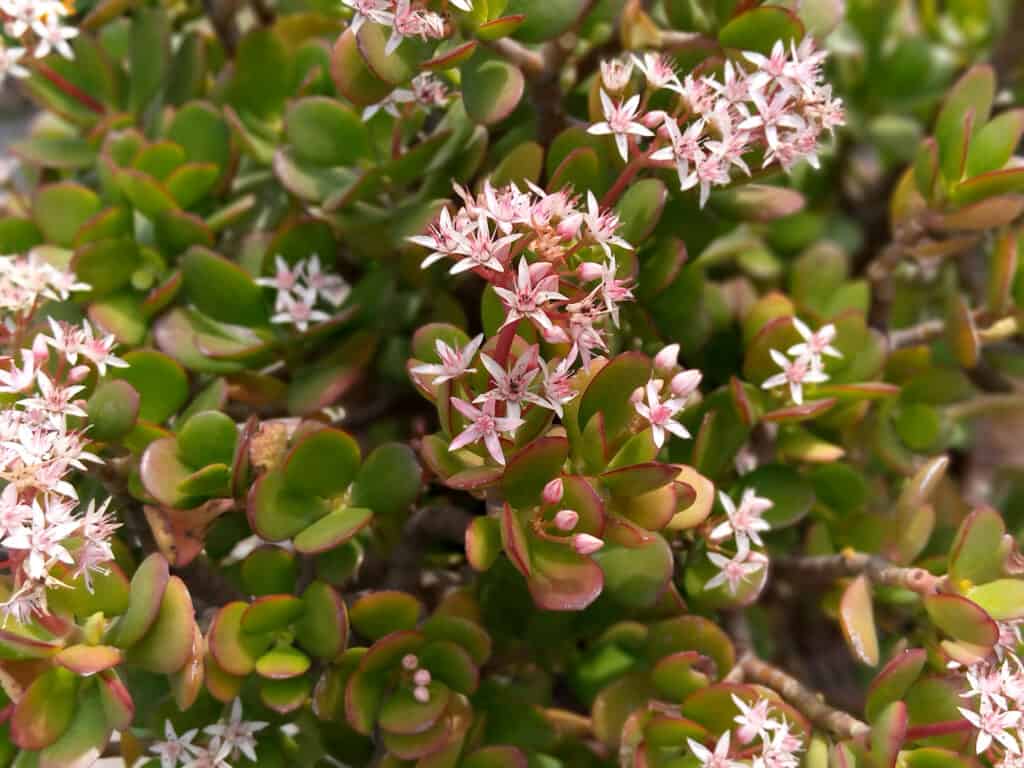There are over 650 succulent types across the world, and jade plants are one of the most popular. All types of jade succulents are handsome, easy-care plants that can survive in a yard with poor, dry soil or equally as well on a warm windowsill. They are so simple to look after and they improve air quality, so what’s not to love?
Let’s look at the various types of jade succulents and try to pick a favorite.
What Is A Succulent?
Succulents are plants that store water in their leaves, roots, or stems. The term succulent doesn’t refer to a plant family, instead it’s an umbrella term for all types of fleshy water-storing plants.
Succulents grow in every continent except Antarctica and most species are native to South Africa. Their recent popularity boost has led to succulent poaching to fuel the increasing demand. Species such as the South African conophytum are under the threat of extinction in the wild.

There are more than 650 types of succulents — and when displayed together, they’re stunning!
©Christina Siow/Shutterstock.com
What Is A Jade Succulent?
Jade succulents are crassula species that are native to South Africa. They have relatively short and thick fleshy leaves, chunky stems, and are named for the jade green foliage that’s usually oval shaped.
Sometimes jade succulents are called money trees, dollar plants, or lucky plants. They’re a popular gift for weddings and housewarmings.
There’s a good reason jade succulents are given as housewarming gifts. Feng Shui associates them with prosperity, but they are also incredibly easy to care for in an indoors environment.
All you really need to grow healthy jade succulents is a bright, indirectly lit windowsill and the ability to resist watering it every day.

Like other indoor succulents, jade plants will thrive with 4-6 hours of sunlight each day.
©Olga Miltsova/Shutterstock.com
Jade Succulent Types
There are more than 200 types of jades in the crassula genus ranging from tiny desk plants to mighty eight feet tall wild shrubs. Let’s take a look at some of the best.
Crassula ovata
The most common type of jade succulent is crassula ovata. It has short thick stems and numerous chunky leaves that range from one inch to 3.5 inches long. If it’s happy, crassula ovata with bloom in winter covering its tips with a flush of dainty white stars.
If you believe in Feng Shui, put your money tree in a room associated with money, such as an office or near your spare change pot!

Crassula,Ovata is commonly known as a money plant.
©HD Photographer Pro/Shutterstock.com
Crassula ovata Skinny Fingers
The name gives its appearance away before you’ve clapped eyes on it’s gorgeous foliage.
Jade plant Skinny Fingers has typical jade colored fleshy foliage, but instead of ovals its leaves are thin and upright, just like fingers.
Each leaf reaches around two inches tall and they over time they can reach three feet tall. It’s a shrubby-looking plant that’s architectural in a yard or home. It has white or pale pink flowers over winter.
Crassula ovata Hummel’s Sunset
Often referred to as the Golden Jade Tree, this is a beautifully colored jade succulent with thick woody stems and oval-shaped lime green and yellow leaves with a red margin. In the winter months, the colors intensify to a golden yellow.
If you have a jade plant collection to expand, this is a contrasting eye-catching shade that’s sometimes mistaken for a bonsai tree.
Crassula ovata Minima
This miniature jade plant reaches a maximum height of 2.5 feet, it’s the foliage that’s mini!
Minima has small red and green pointed leaves and it’s not as dense as other crassulas. In fall, flat clusters of pink flowers appear in star formation.
Pink Jade Plant
Also called Pink Beauty, this jade succulent has pink stems and pink flowers. Its triangular-oval leaves are traditionally jade green, but they are sparse and play a supporting role in the display.
It’ll reach a maximum height of five feet and has the most irresistible fragrance.
Red Jade Plant
Much like its cousin the Pink Jade Plant, dwarf Crassula coccinea has triangular green leaves that form a stem, but shocking red flowers at its tips. Its flowers bloom in the summertime and smell divine.
Crassula arborescens Undulatifolia
Ripple jade is a twisted stem jade with green-gray to bluish leaves. It’s a dwarf variety that’s usually grown in the yard, but it will grow indoors too.
It reaches three feet and has such dense foliage it helps protect soil from erosion and drought.
Crassula Rupestris
This unusual type of jade succulent is also called Baby’s Necklace or the Kebab Bush, but don’t try to eat it because jade plants are toxic.
It’s called these names because the foliage is triangular and flat-packed, with each leaf supporting the one above to create a tower.
The leaf formation is unusual for sure, but it also has brightly colored leaves. Instead of common jade green, Crassula rupestris has greeny-yellow or bluish-yellow leaves with red tips.
It’ll happily grow in a dry yard or on a sunny windowsill.
Crassula tomentosa
The wooly jade plant is sometimes mistaken for a cobweb succulent due the fine hairs that cover its leaves to preserve moisture.
It’s a rosette shaped jade with green and red colored foliage that can reach up to two feet tall outside, but tends to reach no more than one foot indoors.
How To Look After Jade Succulents
Jade succulents are oh-so-easy to care for because they need very little of anything except light.
Here’s how to keep your jade plant looking good:
- Put it in a bright sunny spot, but not in direct burning light if you’re growing indoors. This is because window pane glass intensifies heat and light which creates burns.
- Water it when the compost is dry on top. This can mean leaving it a week, two weeks, or even a month! Don’t be tempted to water more frequently because soggy compost rots jade plant roots. They need well-drained soil.
- Use succulent-specific compost for house-grown jades or free-drained sandy soil outside. This ensures water doesn’t sit on the roots.
- Use fertilizer sparingly and only in the growing months. Be sure to use a specific succulent fertilizer because general plant food is too strong.
That’s all you need to do to have happy, healthy jade succulents, but if something looks wrong, consult troubleshooting below!
Troubleshooting Jade Succulent Care
Here are some potential jade succulent problems:
The leaves are yellow
Some types of jade succulents have yellow leaves, so make sure it’s not a cultivar first.
If you are sure the foliage is jade green, then the problem is most likely overwatering. Let its roots dry out, and water it only when the top soil is dry going forward.
The leaves are shrivelled
Not enough water causes leaf wrinkles. Pop your jade in a sink of water and let it soak up what it needs before letting it drain clear.
It’s leaning!
Your jade needs more light. Chances are it’s leaning towards a window. Put it somewhere brighter, and rotate it once a week to achieve uniform growth.
Damaged leaves and stems
Just cut them away with a sharp pair of scissors. It won’t hurt!
Are Jades a Cactus or Succulent?
All types of jade plants are crassulas and therefore succulents. Cacti are a type of succulent too.
How Big Will a Jade Plant Get?
Jade plants tend to grow as large as their root ball allows.
If you keep yours in a small container, it will remain small. Jade succulents grown outside can reach several feet tall, but it can take years, so patience is required.
Is Jade Plant Toxic?
Yes, the majority of jade succulents are toxic to horses, cats, and dogs. They can also upset human stomachs and cause skin irritation. The ASPCA maintains a full list of toxic plants if you’re ever unsure about a plant’s suitability for your home.
Best Types of Jade Succulents
The best types of jade succulents suit your lifestyle. If you’re looking for yard-grown soil preservers then Ripple Jade is a good choice. If you want an unusual jade plant for your office, then the Crassula Skinny Fingers might fit the bill.
You never know, a well-placed money plant might Feng Shui a Lotto win!
Up Next
- Types of Small Succulents
- How to Care for Most Succulents
- Types of Flowering Succulents
- Types Of Hen and Chicks Succulents
The photo featured at the top of this post is © Jus_Ol/Shutterstock.com
Thank you for reading! Have some feedback for us? Contact the AZ Animals editorial team.






